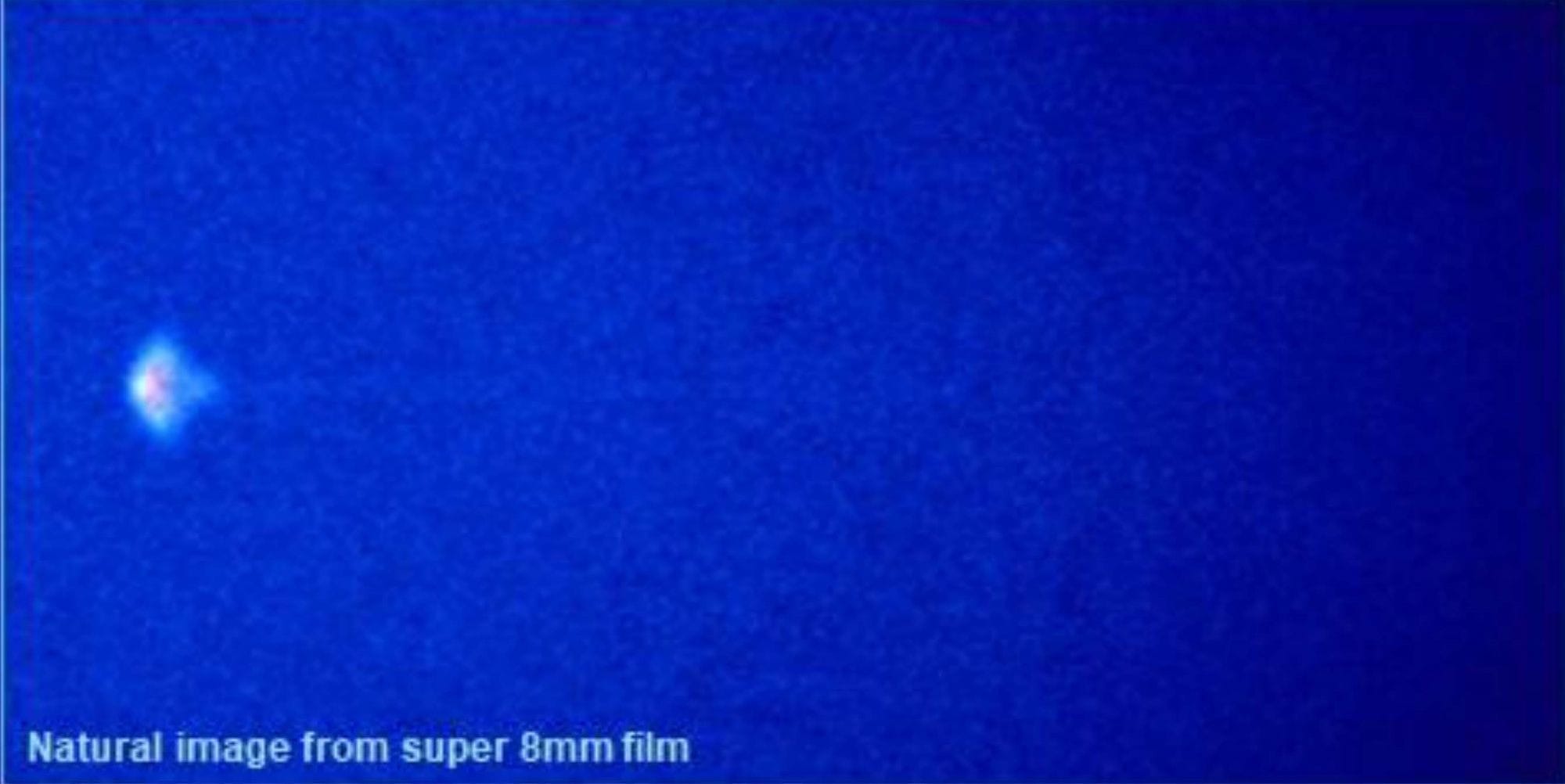Gravity waves and Faraday rings-- or imaginary things? The Ray Stanford movie of December 4, 1980

By Douglas Dean Johnson
@ddeanjohnson on X/Twitter. My Gmail address is my full name
Original publication date: April 4, 2024. Any post-publication substantive additions or revisions are noted in a log that will appear at the bottom of the article (no stealth edits). Note that if you are reading the email version of this article, you will need to use a browser to access the web-based article in order to download embedded documents and audio files. Also, those reading the email version will have to click "view entire message" to access the second half of the article, including the important End Notes.
"So if you take a photograph of a UFO with a polarizing filter...you will see that you'll get rings around the UFO if it has a large magnetic field. This has been observed, and it's been photographed. This is a photograph that [Auguste] Meessen published in 2012 [credited by Meessen to Ray Stanford's 1980 movie], showing what look like Faraday rings around a UFO. However, the magnetic fields generating this have got to be on the order of ten-to-the-eleventh to ten-to-the-thirteenth amp-meters squared [Amp-m^2, amperes times meters squared]--that is the dipole moment of the magnetic field. Huge, huge, huge, huge, huge." – Kevin Knuth, Ph.D., presentation at Sol Foundation Symposium, November 17, 2023
"I have now beautiful examples of the concentric rings around a magnetic light source.... it's a magnetic field, rotating the plane of polarization. And scientists love this...." – Ray Stanford, interview with Jeffrey Mishlove, February 2023
"I now severely regret having brought up [in 1978] the topic of Faraday rotation and magnetic fields for Mr. Stanford to run with." – Daniel H. Harris, Ph.D., former research director for Ray Stanford's "Project Starlight International," open letter, December 11, 2022
"Nothing extraordinary happened on that 1980 flight back from Mexico City. If anything had, I would remember it. The later stories by Ray about it are delusional." – Kitty Bo Wilson, who was seated in the airliner seat immediately next to Ray Stanford during the purported multi-UFO incident in which Stanford claimed to have obtained photographic evidence of UFO-generated "gravity waves" and "magnetic field[s]"
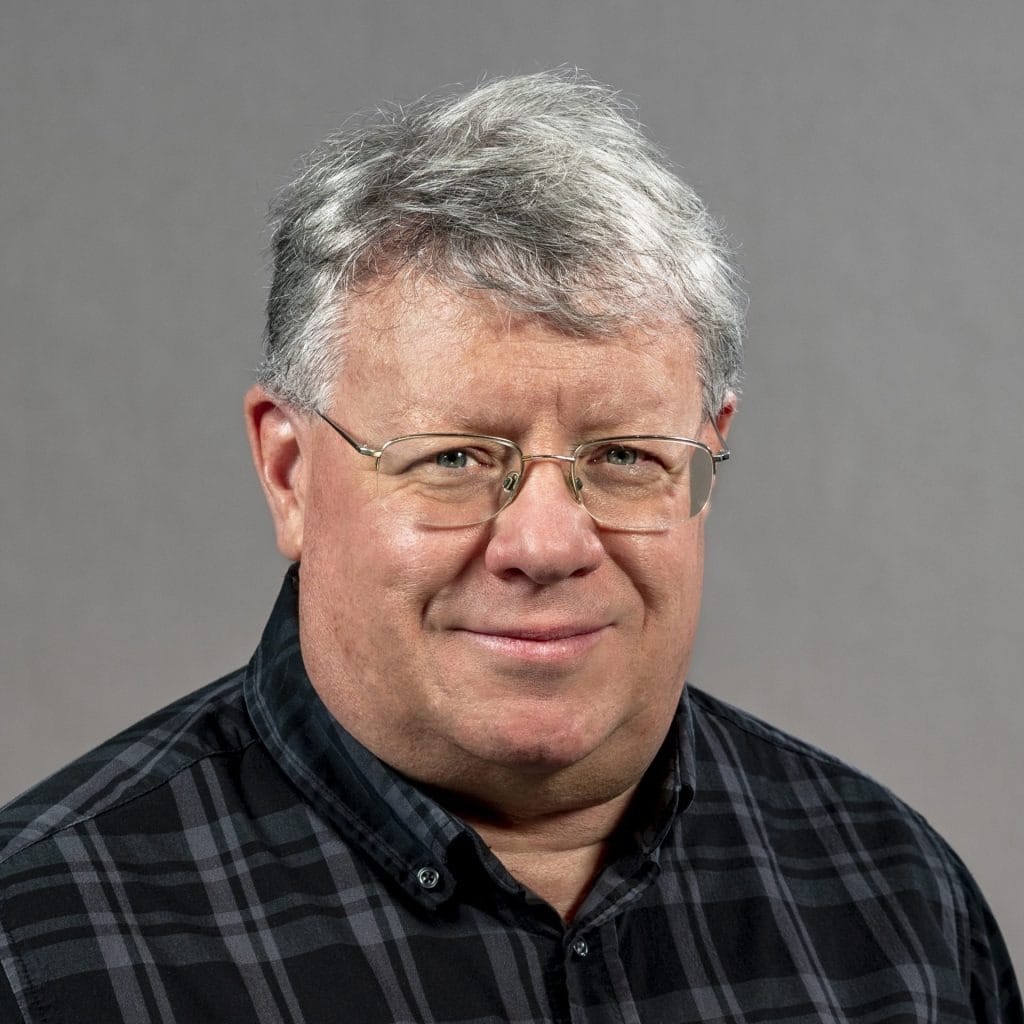
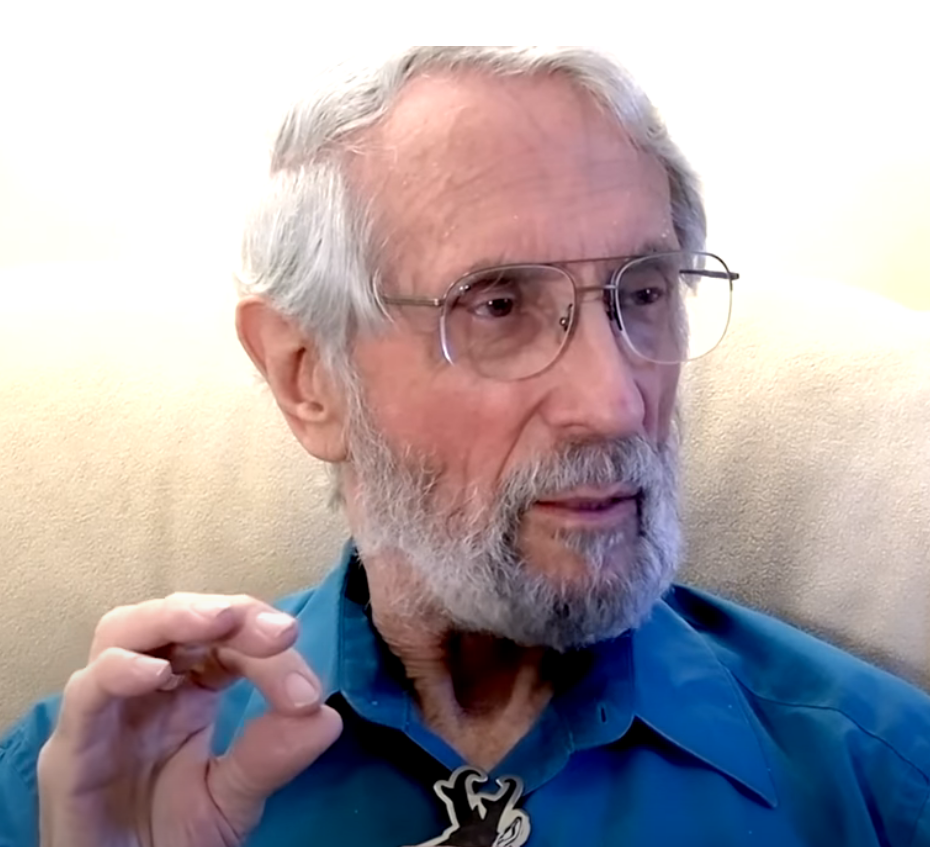
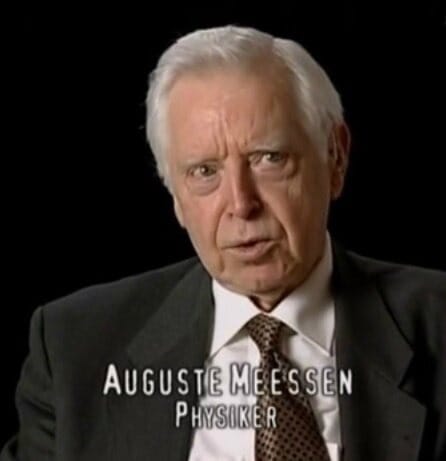
From left to right (or top to bottom): Prof. Kevin Knuth; Ray Stanford; Prof. Auguste Meessen.
Over the past five years, I have written about a number of instances in which various authors have embraced specific photographic images promoted by Ray Stanford, presenting them as evidence or possible evidence of exotic alien technology in action. This article examines another such set of claims– specifically, an image that two professors of physics have separately presented to public audiences as a UFO surrounded by concentric "Faraday rings," suggested to be graphic evidence that some UFOs generate very powerful magnetic fields. The most recent such presentation, by physics Professor Kevin Knuth, occurred on November 17, 2023, as detailed below. The same image and associated claims had been incorporated into a paper by physics Professor Auguste Meessen in 2012.
Obviously, such a photograph – if it proved to have a reliable history, and if the interpretation of what it showed was deemed credible by multiple people with the appropriate technical qualifications – would be of great importance. It would become a major exhibit in the ongoing debate over what constitutes publicly available "hard data" (i.e., evidence beyond eyewitness accounts) supporting the concept that some UFOs manifest technological capacities beyond human state-of-the-art.
Unfortunately, the "Faraday rings" photo flunks both the provenance (history) and objective analysis tests. This turns out to be yet another Ray Stanford tale that has morphed drastically over the decades, and that also bears the Stanford trademarks of highly imaginative interpretations of cherry-picked, grossly enlarged individual frames (or fragments of frames) from a movie that is not available for competent independent analysis.
As readers of my past articles on other UFO-alien-related claims by Ray Stanford well know, in my opinion– and it is an opinion based on decades of observation and extensive investigation – the stories that go with Stanford's purported UFO images, and the claims being made that many of the images contain evidence of exotic alien technologies in operation, are without exception uncorroborated, or worse. Of the many "UFO" images for which Stanford has made portentous alien-tech claims, very few have ever been subjected to any hands-on, competent independent analysis– and where that has occurred, Stanford has generally buried, ignored, or denied the negative findings. [1]
Sometimes the Stanford story that goes with a particular movie or photo morphs so drastically over time that it becomes virtually unrecognizable even to persons other than Stanford who were present for the original incidents, a process that can most politely be described as fictionalization--an example of which I have previously documented in detail in my 2022 article "Plasma Beam– Or Fever Dream?" (see especially Section 6).
In view of Stanford's well documented track record, going back to the 1950s, of making unsupportable UFO-alien claims, in my opinion the use of Stanford-originated UFO-evidence material should be avoided by scientists who want their UFO-related work to be taken seriously.
THE RAY STANFORD SUPER 8 MOVIE OF DECEMBER 4, 1980
The focus of this article is a single Super 8 movie taken by Ray Stanford on December 4, 1980, and the evolving stories that Stanford has told about the "UFO" incident and about what the film shows.
Stanford shot the film through the window of a Braniff-owned Boeing 727 airliner, flying over Mexico on December 4, 1980, at 6:15 PM local time (CST). [2] The entire film supposedly runs for about 25 seconds. [3] Knuth, in 2023, and Meessen, in 2012, displayed a single image derived from that film, which they suggested showed "Faraday rings" around a UFO, which they presented as evidence of a very strong magnetic field.
The image and the "Faraday rings" interpretation originate with Ray Stanford, but they are part of a more elaborate, morphing story and set of claims about the event and the movie. In the more recent versions, the film is said to show multiple UFOs--including a relatively small object that is defined as the focal point in the "Faraday rings" photo, but also a "gigantic" object (now described by Stanford as a "mother ship" or "carrier craft") that (in Stanford's later narrative) produced gravity waves so powerful that it caused "optical collapse" of the background image "hundreds of times" during a film that is less than 30 seconds long. In addition, one slide produced by Stanford is said to show "complex interference fringes...due to the sum of the magnetic fields from the several different craft in the area."
I have read, listened, and examined everything I can find about the December 4, 1980 incident and the associated Super 8 film. I found no substantiation for any of the exotic claims summarized in the preceding paragraph. Moreover, based on the information that is publicly available, I believe that both the "Faraday rings/Faraday Effect" and gravity-waves claims are implausible interpretations of the cherry-picked and manipulated images that have been made public by Stanford.
Below, I will discuss the contents of recorded interviews that Ray Stanford gave to noted UFO researcher and optics expert Richard F. Haines on December 7, 1980 (three days after the event, and before the movie film had been processed) and on February 3, 1981 (after Stanford apparently had possession of the developed film). In neither of those early interviews did Stanford make any claims about multiple UFOs, or a gigantic "mother ship" UFO, or optical collapse of the horizon due to gravity waves, or Faraday rings or "interference fringes." Instead, his initial claim was that he had seen and attempted to film a single "black" UFO with a dome, seen in silhouette against the backlit western sky after sundown, viewed through an airliner window. Stanford repeatedly said that the only other object in the field of view was a large and distant cloud (this fuzzy blob was transformed in the later accounts into an alien "mother ship").
In his conversations with Haines, Stanford acknowledged that he had not questioned any of the other passengers or the crew as to whether they had seen anything out of the ordinary. Stanford even told Haines that his wife Kitty Bo, who was seated to his immediate right, was unaware that he was filming a UFO during the incident.
On April 2, 2024, I asked Stanford's ex-wife (they were divorced in 1985), Kitty Bo Wilson, about the flight from Mexico City to San Antonio. She said, "Nothing extraordinary happened on that 1980 flight back from Mexico City. If anything had, I would remember it. The later stories by Ray about it are delusional."
THE KEVIN KNUTH PRESENTATION OF NOVEMBER 17, 2023
The Ray Stanford "Faraday rings" image most recently found its way into a presentation by Kevin Knuth (a professor of physics at the State University of New York at Albany) at a symposium sponsored by the Sol Foundation, on November 17, 2023. The title of the presentation was "The Physics of UAP, with Some Clues about Their Detection, Monitoring, and Engineering." This is the image that Knuth displayed:
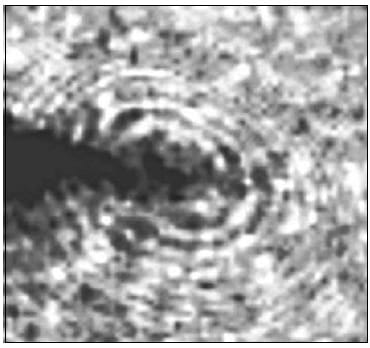
Here is a screenshot taken from the YouTube video that the Sol Foundation posted of Knuth's presentation. The complete YouTube presentation is here; discussion of the "Faraday effect" and the photo is at about the 24-minute mark.

This is what Knuth said during the presentation:
"They [UFOs] also create huge magnetic fields. And the light in the sky is naturally polarized, and these huge magnetic fields can cause an effect called the Faraday effect, which rotates the polarization of the light. So if you take a photograph of a UFO with a polarizing filter...you will see that you'll get rings around the UFO if it has a large magnetic field. This has been observed, and it's been photographed. This is a photograph that [Auguste] Meessen published in 2012, showing what look like Faraday rings around a UFO. However, the magnetic fields generating this have got to be on the order of ten-to-the-eleventh to ten-to-the-thirteenth amp-meters squared [Amp-m^2, amperes times meters squared]--that is the dipole moment of the magnetic field. Huge, huge, huge, huge, huge."
Although Knuth did not mention Ray Stanford in the 2023 presentation, Knuth had a previous association with images from the December 4, 1980 Stanford film, as discussed below, and he knew very well that the image was the work of Ray Stanford.
Note: During the preparation of this article, on March 24, 2024, I emailed to Knuth specific questions about the December 4, 1980 Stanford movie and related claims. Knuth responded on March 27, "I wanted to let you know that I have received your email and will reply. I am traveling at this time and am quite busy, but I will get back to you as this is very important to all of us." However, as of the original publication date of this article on April 4, 2024, I had received no answers to my questions. [UPDATE (April 5, 2025): Late on April 4, 2024, I sent Knuth an email containing a link to this just-published article, and reiterated my interest in any answers he might offer to specific questions that I had raised about the December 4, 1980 Ray Stanford movie, including the questions I had emailed to him on March 24. Knuth promptly replied, "I have no information to provide to you, especially since I do not want to make any statements that are going to end up in a disparaging blog post." However, Knuth did substantively respond to my separate question about whether anything had happened to effectuate his public promises in August 2021 to thoroughly vet and authenticate Ray Stanford's so-called "plasma beam" movie of October 5, 1985, imagery from which Knuth had employed in his August 2021 presentation to a forum sponsored by the American Institute of Aeronautics and Astronautics. I have incorporated Knuth's reply on that matter verbatim into End Note No. 5.]
THE AUGUSTE MEESSEN PAPER AND CLAIMS OF AUGUST, 2012
The "Faraday rings" image was included by Auguste Meessen, a now-retired physicist associated with the Catholic University of Louvain in Belgium, in a paper that was published as part of the proceedings of a 2012 conference in Moscow, Russia. The event, called PIERS, was sponsored by a U.S.-based nonprofit group called The Electromagnetic Academy, which holds such events once or twice every year. The Meessen paper had no co-authors. As far as I can tell, no real peer review process was required for its publication in the proceedings of the Moscow symposium, which included 357 papers and consumed about 1600 pages. [4]
Based on the complete content of the Meessen paper, and based on my observation of Stanford's methods going back to the mid-1970s, I would be willing to wager a considerable sum that Meessen simply accepted the still image and uncritically passed on Stanford's narrative about the event– essentially the same thing that Knuth did in 2021 with respect to images taken from another movie shot by Stanford on October 5, 1985, purporting to show a non-human craft breaking a path through the atmosphere by projecting a "plasma beam ahead." [5]
Not long after I first encountered the Meessen paper, I sent Meessen an email in February 2019 asking him some basic questions about what he had written (e.g., "Did you have the opportunity to examine the original processed Super 8 film? If not, in what form did the Faraday ring image come to you?" And, "Have you considered whether the stretched acrylic' airplane window could have produced an optical artifact such as seen in the Stanford image?" I received no response. During preparation of this article, on March 21, 2024, I again emailed specific questions to Meessen about the "Faraday rings" image. As of the original publication date of this article, I have received no response. Any later response, if received, will be noted in the log of revisions found at the bottom of this article.
Here is everything that Meessen wrote in his 2012 paper dealing directly with the "Faraday rings" photograph:
Ray Stanford documented this [Faraday Effect] phenomenon in a very impressive way. On December 4, 1980, while flying from Mexico City to San Antonio, Texas, he spotted anomalous objects in the sky, grabbed his Super 8 Canon camera and filmed for about 25 s at 70mm focal length. This happened after sunset, but the Sun was still illuminating the sky in the direction he was filming. Vertical sunrays were scattered in the west at about 90±, yielding horizontally polarized light that passed near the objects. The beam-splitter of the camera acted like an analyser, by reflecting mainly horizontally polarized light toward the film. Viewing the resulting pictures one by one, Ray Stanford discovered in one frame an extraordinary set of at least 12 white concentric rings (Figure 5).
They were centered on one of the small objects dashing in various directions. By chance, this picture was taken exactly at the instant where one these objects encountered a long unidentified structure (dark edge in Figure 5). To reverse its motion, the smaller object produced a very intense magnetic field and a short ionization pulse, the pictures being taken at 54 frames per second. The white rings resulted from horizontally polarized light and many 180± rotations near the object. Its symmetry axis was oblique with respect to the plane of the film, yielding ellipses instead of circles. It is possible to account for the progressive change of the distances between successive rings by considering the velocity V of free electrons in very strong magnetic fields and auto-ionization, proportional to the average kinetic energy of free electrons. Ray Stanford discovered also some other Faraday rings on other occasions.
In my opinion, the quote immediately above was not a scientific presentation– rather, it appears that Meessen merely acted as a stenographer for claims transmitted to him by Ray Stanford, including claims that display Stanford's characteristic imaginative omniscience (e.g., a smaller object "produced a very intense magnetic field and a short ionization pulse" in order "to reverse its motion").
The entire 2012 Meessen paper is embedded below in PDF format.
(Aside from the "Faraday rings" image and story, the 2012 Meessen paper uncritically transmitted certain other unsubstantiated "hard data" claims by Ray Stanford that are not related to the December 4, 1980 event, and which therefore are not addressed in this article. Suffice to say here that I know enough about those unrelated claims to personally regard them also as unsubstantiated and highly dubious.)
The discerning reader may inquire: How do the presentations by Meessen (in 2012) and Knuth (in 2023) square with other available information about the event and movie of December 4, 1980, including earlier statements by Stanford himself? I will now explore those questions.
RAY STANFORD'S ACCOUNT THREE DAYS AFTER THE EVENT
On December 7, 1980– three days after Ray Stanford took the movie – he telephoned Richard F. Haines, who recorded the conversation on two cassette tapes. Haines was at that time employed as a scientist at the NASA-Ames Research Center at Moffett Field in California; he was a psychologist, with special expertise in the field of optics and visual perception. Haines was also well-known as a UFO researcher during this period. This conversation occurred before Stanford's Super 8 film had been processed – in fact, much of the December 7 call (which ran about 31 minutes) was taken up with advice from Haines about how he thought Stanford should proceed with respect to the handling of the undeveloped film.
What follows is my summary of the story that Stanford told to Haines, presented in paragraphs that are organized by topic, and do not strictly follow the chronological order of the phone conversation. The entire recordings have been converted to the digital .mp3 format and are embedded below.
-- Ray Stanford said the airliner had three rear-mounted engines and three-across seating (i.e., a Boeing 727). The Stanford party was seated on the left side of the plane, in row 9. Stanford's daughter (age 2-1/2 years) was seated at the window seat (9A) to Stanford's left, Stanford was in the center seat (9B), and Stanford's then-wife Kitty Bo was seated to Stanford's right, in the isle seat (9C).
-- Shortly after takeoff, as the plane was gaining altitude (at about 12,000 feet on the way to 39,000 feet), and on a northward heading of 350 degrees magnetic, at 6:15 PM CST (17 minutes after sunset), Stanford, looking out the window to the west, said he saw a single fast-moving object emerge from behind a large cloud and turn southward. He described the object as a "a fat oblate spheroid or a very fat disc...with a substantial dome on top," silhouetted against the backlit western sky. ("It was a black silhouette.") Stanford said that the only thing visible in the western sky, other than the black "UFO," was the large cloud ("a feathery sort of cloud"), that he estimated as being 20 to 80 miles away. He began to shoot out the window with his Canon Super 8 movie camera, which had a 70 mm telephoto lens. The camera was initially set for 24 frames per second. However, Stanford soon interrupted his photography to reset the camera for "slow motion," which changed the frame rate to 54 frames per second, and he shot the rest of his film canister at that speed.
-- In this detailed conversation, Stanford quite clearly stated that there was only one UFO, which appeared "black" in silhouette against the backlit post-sundown sky (a "silhouette, which of course comes across at that distance very two-dimensional, like this flat oval...and then this sizeable dome..."), with some sort of vapor whirling around it. Stanford said explicitly that the only other object in the sky was a large cloud, "only one cloud," which he estimated at 3 to 5 degrees in apparent width (which would be six to ten times the apparent width of a full moon). "I was fortunate that I had the cloud as an absolute reference object all the time during the filming," Stanford told Haines.

-- Stanford estimated the UFO he filmed was "I think about one-fourth or one-fifth the size of the full moon," as viewed with the naked eye (which would be 6 to 8 arc minutes), and estimated that at one point it was traveling on the order of 2,000 miles per hour.
-- Regarding his wife Kitty Bo, seated immediately to his right, Stanford told Haines that during the event, "I called out to her, I said, 'Kitty Bo, I am filming a black UFO! It is moving like a bat out of hell to the left, across that cloud! Look!' But you know that she swears up and down that she never even heard me? It makes me furious." [Kitty Bo's comment to me about the event has already been reported higher up in this article.]
-- Stanford said he did not speak to the flight crew about seeing a UFO. He said that after the event he did send the "flight engineers" a note asking for information on the plane's location, speed, and other pertinent data as applicable to 6:15 PM, and got a note back providing that data.
-- Haines tactfully pointed out that Stanford had made a number of previous claims to having filmed UFOs through airliner windows [see discussion below], and suggested that this might make some people skeptical of yet another such claim. Haines suggested that Stanford turn over to Haines the unprocessed film cannister, which Haines would then submit to the Center for UFO Studies under a "John Doe" designation for independent processing and evaluation. (This part of the discussion began in Part 2 of the December 7, 1980 recording, at about 6 minutes.) Haines also offered specific advice that the film receive special processing to "push" the film speed (light sensitivity), a tricky process. Although Stanford sounded receptive to all of Haines' suggestions, I do not know what procedures he actually followed with respect to processing the film.
The complete audio files of the December 7, 1980 Haines-Stanford conversation is embedded below; the first recording runs about 31 minutes and the second recording about 18 minutes.
RAY STANFORD'S COMMENTS TWO MONTHS AFTER THE EVENT
On February 3, 1981 – two months after the filming – Ray Stanford called Richard Haines again. An unknown amount of the conversation was not recorded, but at some point Haines began recording. (Haines recorded the date after the end of the conversation.) Since the first part of the conversation was not recorded, the recorded exchange is a bit confusing and may be subject to different interpretations. As I understand it, Stanford had received and viewed the processed film, but Haines had not yet seen the film. I gather that Stanford had sent Haines a letter describing his initial impressions after seeing the film, and was now calling to follow up with Haines, but Haines had not yet carefully studied Stanford's letter.
Throughout the conversation, Stanford again speaks only of the "cloud" and of a single UFO; he makes no reference to multiple UFOs or a to a gigantic mothership UFO. Nor does Stanford during this call refer to the film containing evidence of any exotic technological effects– although if he had just received the developed film, I would not put much weight on that omission, since he probably would not have had time to execute any of his favored gross enlargements and enhancements.
The complete recording made by Richard Haines of the February 3, 1981 conversation with Ray Stanford is embedded below; it runs about 14 minutes.
THE LONG GAP – 1981 TO 2003
Following the February 3, 1981 Haines-Stanford call, there is an important gap in the record that remains to be filled by further investigation. Until an interview with Ray Stanford that was broadcast on March 29, 2003 – 22 years later (an interview that is discussed in detail below), I found no record that Stanford, Haines, or anybody else said anything publicly about the December 4, 1980 film or what it supposedly showed. If Stanford, Haines or anyone else involved in early 1981 really believed that the film showed convincing evidence of exotic alien technology in operation, I would find this long silence puzzling.
It is certainly possible that Stanford did talk about or write about the 1980 film, at some point between receiving the processed film in 1981, and the interview of March 29, 2003, in a venue that has so far escaped my attention– and if so, I would be very interested in examining what he said and analyzing how the claims about the film evolved. However, as we will see, during the March 2003 interview, Stanford himself said he was revealing things he had never made public before.
THE RAY STANFORD "NEVER TOLD PUBLICLY BEFORE" INTERVIEW OF MARCH 29, 2003 (22 YEARS AFTER THE EVENT)("GRAVITY WAVES" REVEALED)
On March 29, 2003, Ray Stanford was guest on a radio/podcast program "Strange Days...Indeed," hosted by Errol Bruce-Knapp and Ian Rogers. During this hour-long program, Stanford spent about four minutes describing what he claimed to have witnessed and photographed on December 4, 1980. During this interview, Stanford said that he was relating a story that "has never been told publicly before" – a noteworthy statement, since this interview occurred more than 22 years after the purported incident.
The tale had grown greatly since 1980. (I regard this as another example of the "fictionalization" process that I have painstakingly documented in some other Stanford-claim cases, in earlier articles.) In the new Stanford narrative, the black domed UFO was relegated to secondary role – the star of the show had become "the big object that I call a carrier craft or mothership" (previously, a cloud), and the marquee claim for the film was now that it contained "possibly dramatic evidence of a gravity-like effect warping the back lighting from the horizon," produced by the "mother ship."
Some readers here may be surprised to learn that in this supposedly first-ever public interview about the 1980 event, after having had 22 years to personally analyze the Super 8 film, Stanford did not even mention having captured any images of "Faraday rings" or the "Faraday effect" – the aspect on which Meessen and Knuth later put such weight. Nor did he mention "interference fringes from the Faraday Effect," as claimed in a 2021 PowerPoint discussed below.
The transcript of Stanford's complete narrative regarding the December 4, 1980 incident, from the March 29, 2003 interview, follows:
Ray Stanford: My former wife and I – not my present wife, my former wife [Kitty Bo Wilson] and I, and my daughter [age 2-1/2 years] – were flying back from Mexico City on December 4th, 1980, in daylight. We were north of Mexico City. We were north of the Teotihuacan pyramid system there. We were above what's called the Tizayuca radio beacon. There was a gigantic object in the west that had a small object that was approaching from the north. This [smaller] object was quite bizarre – I won't try to take time to describe it here. But it was approaching this gigantic object that had two beam-like effects off the left end of it that were kind of vibrating, and another effect on the end in the direction from which the smaller UFO was approaching. And I filmed this thing. And off to the left of this tubular-shaped thing, was a triangular object, which had, it looked like what I would guess to be maybe be a kind of ion vapor or something churning around it– a big triangular thing.
I didn't see with the naked eye, but once we had the film, you can actually see what appears to be totally parallel, columnated, bright beams that are exchanged at times between these objects, as if some kind of communication were going on.
But relative to your question regarding gravity: It happens that we were up at, I think it was about 16 [16,000] or 26 [26,000], I forget, thousand feet, and you could see on the western horizon clouds were covering the ground, but mountains were sticking through the clouds right at horizon. And this was very neat, because directly under this big object, that I'll call a carrier vehicle or mothership, whatever you prefer– I was filming at 50, I believe it was 54 or 56 frames per second. During five frames, at that speed, the mountains would optically become warped, as though by a gravity-like effect. Einstein has shown that gravity affects the path of light. And they collapse during five frames, and then 15 frames optically come back up to their normal height. And throughout this long film, the mountains collapse and raise back up repeatedly, again and again and again.
Now this in itself would be a possibly dramatic evidence of a gravity-like effect warping the back lighting from the horizon. But beyond that, what is absolutely startling is that you see the horizon with mountains all along it. But the mountains collapse most completely--when I say collapse I'm talking about an optical warping until they become flattened– they collapse most completely directly under this gigantic carrier craft. And the further you get out from it to the sides, they collapse less. And this happens hundreds of times. This phenomenon repeats in those cycles each time. You see that, in other words, that the warping effect is radial to this big object, to which the smaller object had been maneuvering. So here we have electronic recordings of gravity waves with a recording gravimeter [a claim related to a different date, not discussed in this article], and we have optical recording of the effects of gravity waves upon horizon structure beneath this big object.
Errol Bruce-Knapp: And you've held onto all of this for all of this time and really haven't put it out there. Kind of a smoking gun you've just shot off there, Ray Stanford!
Ray Stanford: I'd say so. And by the way, Errol, this is a first for your show, because that has never been told publicly before.
Errol Bruce Knapp: Ian and I were sitting here discussing that, looking at each other and asking, "Well, have you heard that before? No. Have you? No."
Ian Rogers: No – it's a first time for me. I'd love to see a copy of that film.
Ray Stanford: You will someday, believe me. It's quite striking – quite startling.
As documentation and to provide full context, I have embedded here an .mp3 audio file of the entire 2003 interview; the segment transcribed above begins at about 22 minutes into the 62-minute recording, and runs to about the 26-minute point. (Fair Use under 17 U.S. Code § 107 for noncommercial purposes of investigative journalism, scientific research and debate, education, commentary, and criticism.)
THE KNUTH-STANFORD POWERPOINT OF JULY 2021: FARADAY RINGS AND "COMPLEX INTERFERENCE PATTERNS"
Quite aside from Meessen's 2012 paper, Kevin Knuth ought to be well familiar with Stanford's claims about the December 4, 1980 film. In June 2021, Knuth submitted for intended presentation at a conference of the Scientific Coalition for UAP Studies a PowerPoint slide show titled "The Physical Observables of UAPs," co-authored by Ray Stanford [6] – 67 slides in all, including 22 slides produced by Stanford. The Stanford-produced slides contained images from six different claimed UFO events purportedly witnessed by Ray Stanford, including three slides derived directly from the December 4, 1980 film and another slide containing related explanatory material about "Faraday rotation." The four slides related to the December 4, 1980 film are reproduced in total below, including the original captions; I have added nothing. (Fair Use under 17 U.S. Code § 107 for noncommercial purposes of investigative journalism, scientific research and debate, education, commentary, and criticism.) [7]
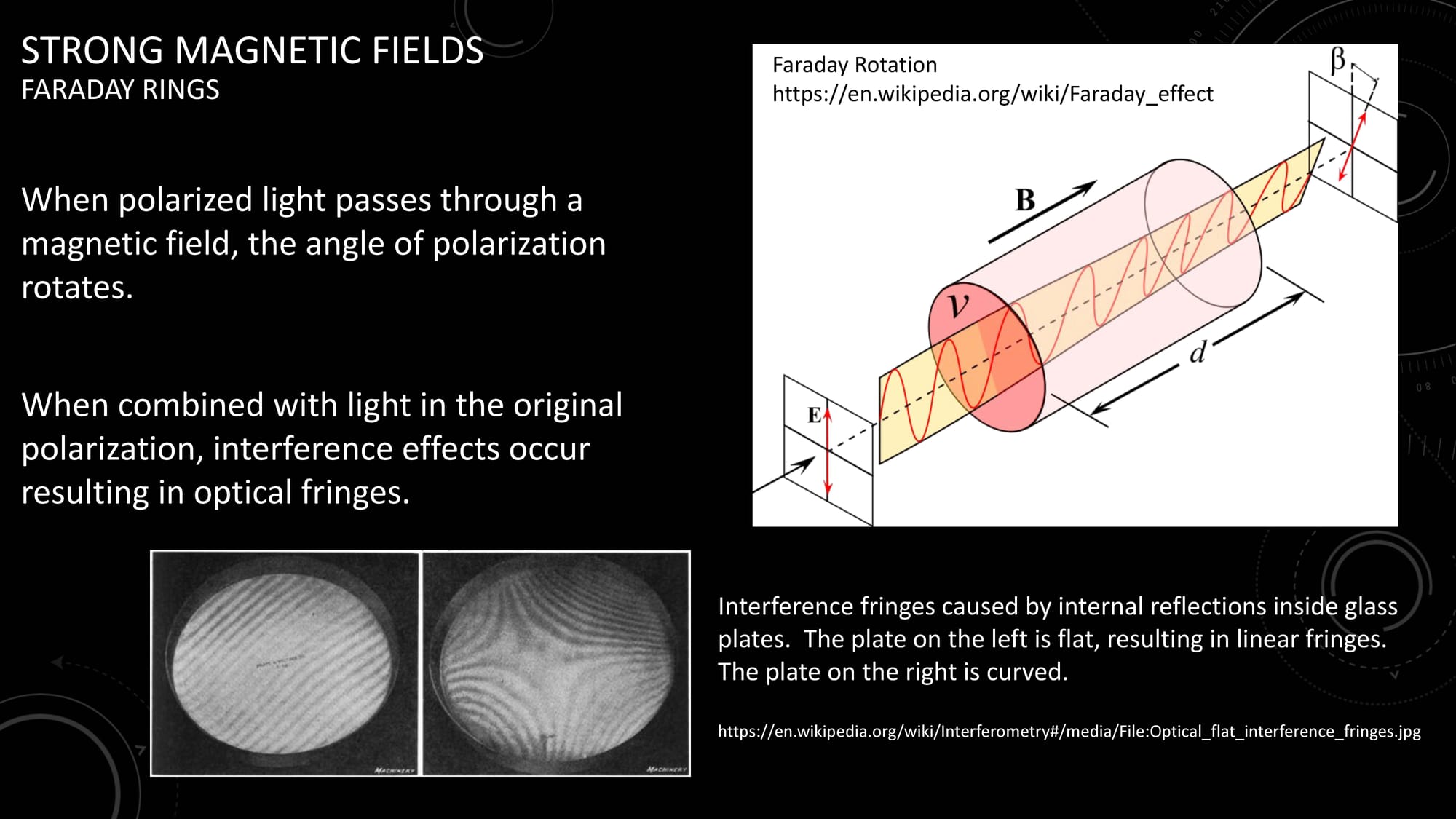
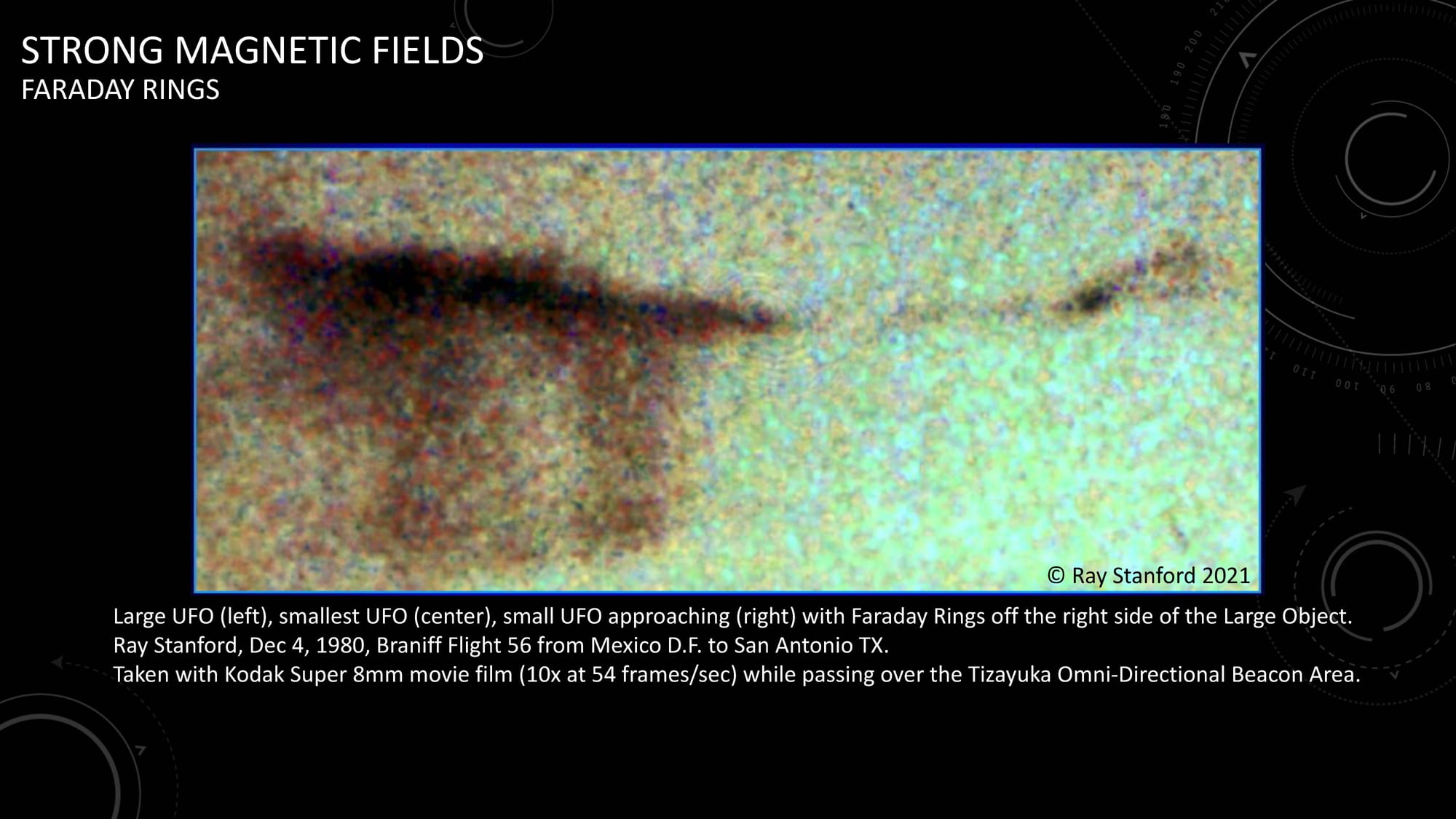
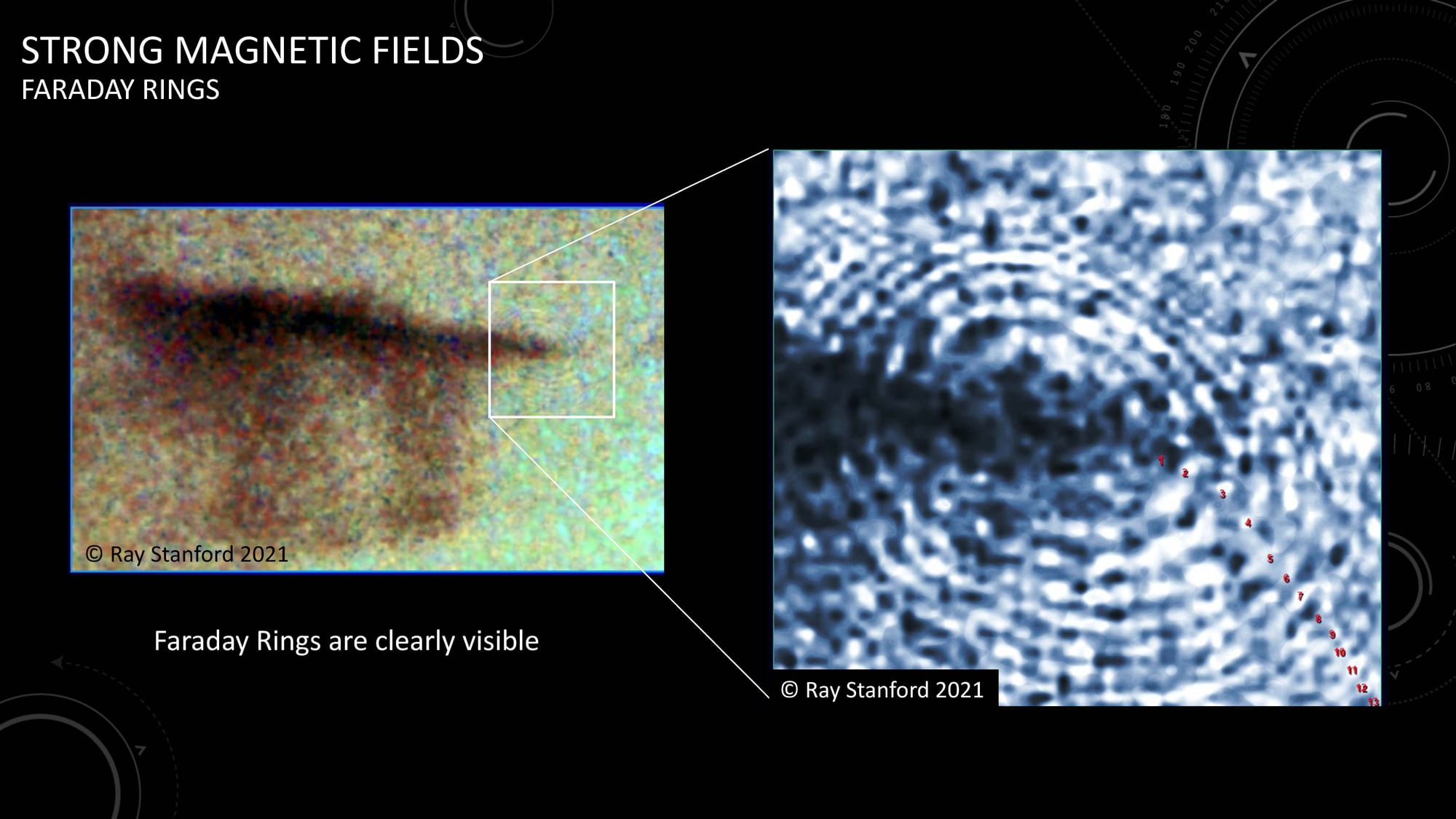

Recall that in 2012 Meessen wrote that Stanford had, while "viewing the resulting pictures one by one [8], discovered in one frame...at least 12 white concentric rings." [italics in original], and he added, "By chance, this picture was taken exactly at the instant where one of these objected encountered a long unidentified structure...To reverse its motion, the smaller objected produced a very intense magnetic field..."
Clearly, the second and third slides from the Knuth-Stanford PowerPoint, as shown above, are derived from that single frame to which Meessen referred. But the final slide in the 2021 Knuth series, which I will call "the false-color slide," does not appear to be derived from the same frame – rather, it appears to be an extreme enlargement (the fine grain structure of the Kodachrome emulsion is visible, with its typical random distribution) of a portion of a different frame, from among the hundreds of exposed frames that Stanford had to choose from. [9] In any event, in the "false-color slide," patterns of parallel white lines are indeed evident, as in the image highlighted by Meessen and Knuth--but in the false-color slide, the white lines appear not as tidy concentric ovals (the basis of the "Faraday rings" interpretation), but flow in curved and wavy lines running every which way– rather like corn rows planted on a set of rolling hills, as viewed from the air.
This inconsistency posed little difficulty for the ever-fertile imagination of Ray Stanford– his PowerPoint slide caption breezily explained, "The complex interference fringes from the Faraday Effect is due to the sum of the magnetic fields from the several different craft in the area." Here we have an example of the familiar Ray Stanford practice of piling hyper-detailed subjective extrapolations on top of each other, each advanced in a tone of confidence that the credulous and the uninitiated may find convincing.
RAY STANFORD'S METHODS OF PHOTO INTERPRETATION
As I have detailed elsewhere, when Stanford receives a developed movie or still images back from a photo lab, his general practice is to greatly enlarge individual frames. Because all of Stanford's supposedly remarkable UFO-evidence images were made with emulsion films (not digital cameras), gross enlargements brings into view the physical silver grains that are randomly distributed on the film backing material. In those random mottled grain structures, Stanford very often convinces himself that he sees evidences of exotic alien structures technologies in operation--and even, in at least one case that I have detailed elsewhere, an actual alien pilot, so clearly "you can count the fingers on his hand."
In some cases, after viewing such enlargements, Stanford's original accounts of the "UFO" incidents are adjusted, sometimes drastically, to match what he now insists the photographs show. As an example, in my April 2022 article "Plasma Beam, or Fever Dream?", Section 6, I documented in detail the fictionalization of an incident that occurred on December 10, 1975, for which I was personally present and had retained detailed contemporary records; the actual event and contemporary documentation bore little resemblance to the fantastic adaptation that Stanford had prepared as part of the PowerPoint submitted for intended presentation at the June 2021 conference of the Scientific Coalition for UAP Studies. Near the bottom of this article, I quote Dr. Daniel H. Harris, one-time Research Director for Stanford's "Project Starlight International," relating from his first-hand experience other examples of Stanford's highly subjective, highly imaginative approach to UFO-photo interpretation.
THE SIZE OF THE SO-CALLED "FARADAY RINGS" IMAGE; THE LIMITATIONS OF THE SUPER 8 FORMAT
Getting back to the single image adopted by Meessen and Knuth in 2012 and 2023: I do not know whether the second slide in the PowerPoint sequence includes the entire Super 8 emulsion frame, or if the image was cropped. Let's look at that image again. (Fair Use under 17 U.S. Code § 107 for noncommercial purposes of investigative journalism, scientific research and debate, education, commentary, and criticism.)

Merely for the sake of discussion, let us assume that this slide shows the full, uncropped original frame from the Super 8 emulsion film. A full frame of Super 8 film measures only 5.79 x 4.01 mm – that is, less than one-quarter inch across in the longer dimension (0.228 inches by 0.158 inches). By my measurement, the "concentric rings" span about 15% of the width of the complete image. Thus, on the original emulsion, the entire set of "rings" that Meessen and Knuth displayed would be only about 1 millimeter across– which is about 4 percent of one inch.
This means that if you are viewing the "Faraday rings" image on a desktop computer and make the image 4 inches across, the image is about 100 times as wide as what is actually recorded on the Super 8 emulsion. The high degree of enlargement necessary to make the picture that Meessen and Knuth displayed is also showing us silver grains and other physical features of the emulsion.
(If the image shown in the second PowerPoint had been cropped before the PowerPoint slide was produced, removing parts of the image that appear in the original Super 8 frame, then the size of the "rings" on the actual emulsion would be even smaller.)
Keep in mind that Super 8 was basically a home-movie format. Given the very small image size and low resolution, the format was not designed for use as a scientific instrument. According to Wikipedia, "the format is still regularly used by artists and students. Some seek to imitate the look of old home movies, or create a stylishly grainy look." [italics added for emphasis]
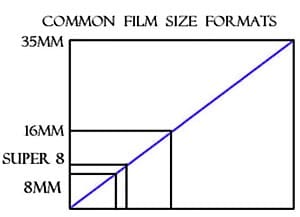
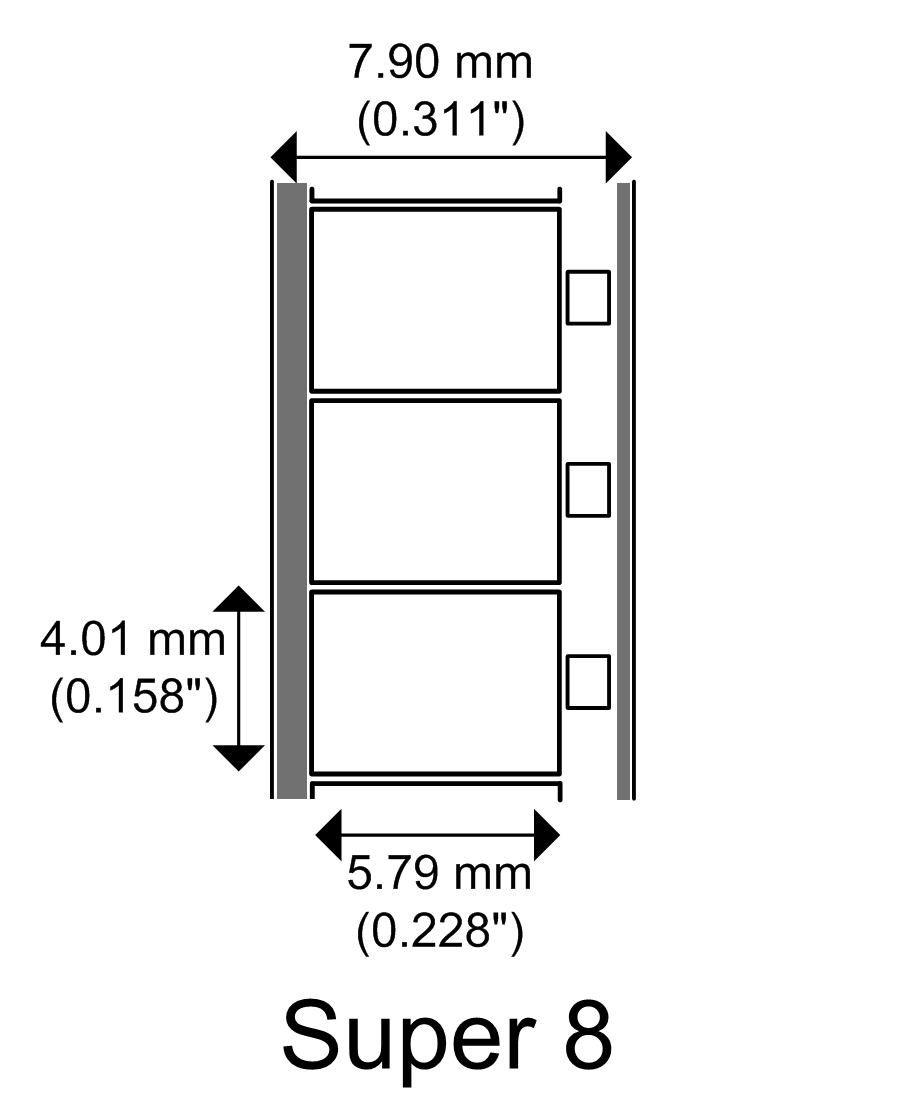
THE FREQUENCY OF RAY STANFORD FILMING "UFOs" THROUGH AIRLINER WINDOWS
The uninitiated reader first encountering Ray Stanford's story of December 4, 1970, might think Stanford was very lucky to have seen a UFO outside an airliner window, which for most people would be a very uncommon experience. But it was not very uncommon for Stanford. Stanford claims to have personally photographed UFOs on many dozens of occasions (on 51 occasions from 1961-1997 alone, and on other occasions earlier and later), and to have obtained in total "thousands" of frames of emulsion images of UFOs. Moreover, Stanford has claimed to have filmed UFOs specifically through airliner windows on many occasions.
For example, in a fundraising solicitation sent to a mailing list in April, 1980, headed "Dear Friends of P.S.I.," Stanford wrote: "From November 1977 through March 1980, the project has successfully obtained eight color motion-picture films of UFOs: Three of them from jet airliners in daylight; one from a jet airliner at night; and four more from the ground in daylight."

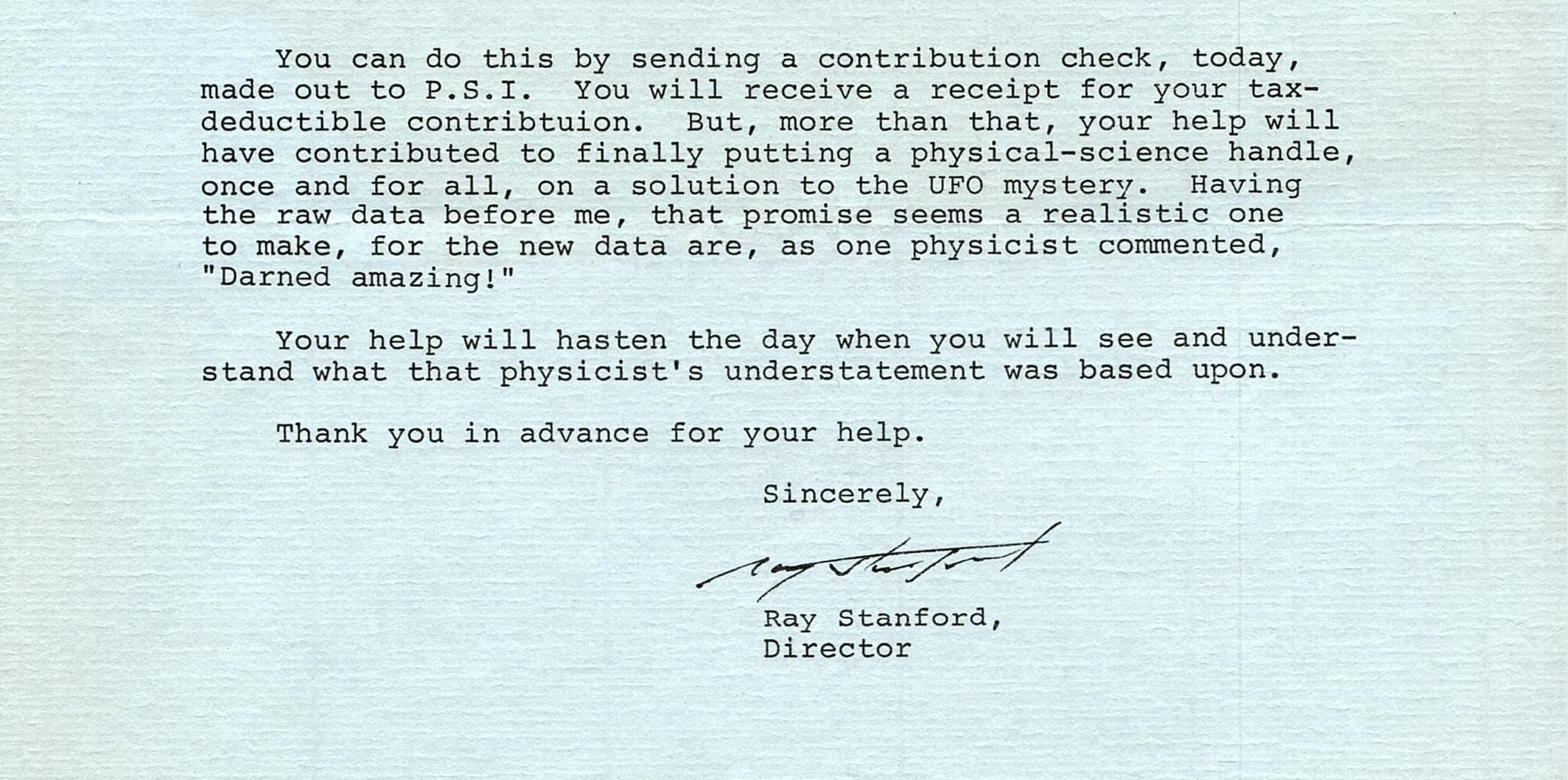
Note that this total (four UFO films taken by Stanford from airliners in a 28-month period) did not include the Mexico film, which was made eight months after that fundraising letter was sent out.
When Ray Stanford called UFO researcher Richard F. Haines on December 7, 1980 (as recorded in the audio file embedded above)– before the film had been developed– Haines suggested that in view of Stanford's multiple claims to UFO movies shot through airline windows, the new film would be received skeptically by some ("the more one gets nowadays, the more it raises eyebrows," Haines said tactfully), and on this basis, Haines urged Stanford to allow him (Haines) to have the film processed and analyzed under a "John Doe" designation, "so that you're out of the loop completely." It is not clear whether Stanford subsequently followed such a procedure in this case, but it is noteworthy that Haines thought it prudent to suggest it.
THERE IS NO CORROBORATION FOR A UFO EVENT OVER MEXICO ON DECEMBER 4, 1980
For most of Stanford's most celebrated UFO photo stories, there are no true corroborating witnesses– there are only Stanford stories about purported witnesses, who most often are not available to researchers. In some cases, however, people who were present actually have been located, and have given accounts widely at variance with the Ray Stanford versions.
It the December 4, 1980 case, Stanford claims to have filmed multiple UFOs as the airliner flew over a well-populated area in central Mexico– with one of the objects described as "gigantic." Stanford further asserts that a gravity field produced by the "mother ship" repeatedly distorted the images of distant mountains, while the "Faraday rings" proved the existence of a super-strong magnetic field around a smaller craft. Yet neither Stanford or anyone else has produced any testimony of any witness, or any press report, or any report to any UFO research group, or any other evidence corroborating the presence of a huge craft in the sky. Nor are there any corroborating reports or records of observations of the effects of the supposedly massive gravitational and magnetic forces that Stanford believes were in play that evening.
Stanford said in one interview that he did not know if the pilot of the airliner noticed anything.
As already noted, Stanford's wife, who was seated in the seat immediately to his right, told me, "Nothing extraordinary happened on that 1980 flight back from Mexico City. If anything had, I would remember it." Stanford himself told Haines, three days after the event, "I called out to her, I said, 'Kitty Bo, I am filming a black UFO! It is moving like a bat out of hell to the left, across that cloud! Look!' But you know that she swears up and down that she never even heard me? It makes me furious."
Thus, this is in no sense a "multi-witness" case.
Nor was any corresponding record found in UFOCAT, a large computerized database of UFO reports. Mark Rodeghier, the Scientific Director of the Center for UFO Studies (CUFOS), which was founded by J. Allen Hynek, told me on April 2, 2024: "In UFOCAT there is only one report for Mexico in December 1980, which was on December 20 at 11 PM local time, in Mexico City, from a high rise, with the original source being NUFORC [National UFO Reporting Center]."
RAY STANFORD'S 2023 DISCOURSE ON HOW HE BELIEVES HE HAS PHOTOGRAPHED UFO-ASSOCIATED FARADAY EFFECTS ON MULTIPLE OCCASIONS
In February, 2023, psychologist Jeffrey Mishlove posted on YouTube three videos of interviews with Ray Stanford, in which Mishlove recorded Stanford telling many tales related to UFOs and other things--all received by Mishlove with wide-eyed expressions of completely uncritical indulgence and amplification. In one of the videos, posted on or about February 18, 2023, Mishlove presented more than one hour of Stanford talking about UFO photos. Near the beginning, the two men discussed a Stanford claim to have personally photographed UFOs on 51 occasions between 1961 and 1997 alone.
I present here one five-minute clip from the 65-minute interview, in which Ray Stanford discussed how he believes he has been able to photographically record the Faraday Effect on multiple occasions. (Fair Use under 17 U.S. Code § 107 for noncommercial purposes of investigative journalism, scientific research and debate, education, commentary, and criticism.) As Stanford related these claims, some of the images shown were those derived from the December 4, 1980 film.
In this clip, Ray Stanford said: "I have now beautiful examples of the concentric rings around a magnetic light source. And when you get this, in this kind of circumstance, where you're using polarity of light, it it's indisputable– it's a magnetic field, rotating the plane of polarization. And scientists love this....And that strong magnetic field, when you get so many rings around it, as we have in some of these [photographic] examples, you know you have an extremely powerful magnetic field."
A five-minute clip from video "Analyzing UFO Photographs with Ray Stanford," from "New Thinking Allowed" series by psychologist Jeffrey Mishlove. Clip presented here as Fair Use under 17 U.S. Code § 107 for noncommercial purposes of investigative journalism, scientific research and debate, education, commentary, and criticism.
THE TESTIMONY OF DANIEL H. HARRIS, PH.D., RESEARCH DIRECTOR, PROJECT STARLIGHT INTERNATIONAL, REGARDING RAY STANFORD'S SUBJECTIVE METHODS OF INTERPRETING "UFO" PHOTOS
Daniel H. Harris, Ph.D. (astronomy, University of Arizona) was Research Director for Ray Stanford's "Project Starlight International" from September 1, 1977, through December 1978. On December 7, 2021, Dr. Harris released an 11-page "open letter" in which he offered detailed observations regarding Stanford's photo-interpretation practices and his basic proclivities pertaining to UFO-evidence claims.
Harris and Stanford parted company two years before Stanford took the film in Mexico, so Harris offered no comment directly on the Mexico film. Nevertheless, you will find that some of Harris's observations are certainly pertinent to Stanford's claims about the Mexico film and its purported "Faraday rings." Harris wrote:
Ray Stanford has invoked my name explicitly in connection with another “UFO event,” a Super 8 movie that he took through an airliner window, near Memphis, Tennessee, on December 12, 1977. In a lengthy paper Mr. Stanford presented at a symposium of the Mutual UFO Network (MUFON) in 1980, he wrote (on page 154): "A tape-recorded account of the sighting was made the morning after, at the P.S.I. offices, and this was witnessed by several persons, including physicist Daniel Harris, Ph.D., who signed the author’s [Ray Stanford’s] drawings made during the account as a witness to the drawings and to certify that the account was given before the film was ever processed."
That much is true, I did witness the recording and drawings– but I do not agree with Mr. Stanford’s very complex interpretations of what the processed and greatly magnified film allegedly showed, which include [p 153, of MUFON 1980] “a relatively gigantic, apparently glowing, iridescent, tubular thing,” which emitted flowing luminous substances, and so forth. Further on Mr. Stanford wrote in the 1980 MUFON paper, on page 156: "Daniel H. Harris, Ph.D., a physicist who has studied a P.S.I. film record (12/12/77) of these phenomena repeatedly occurring, states that the filmed effect “is likely a shock phenomenon and, then, an expanding shock wave,” made ‘visible’ to the film...”And on page 161: "The aforementioned physicist, Daniel Harris, has studied the film and suggests that – since the film was taken with polarization bias (via the aircraft window which formed a Brewster angle to the objects being filmed and via the beam-splitter), the rings could be due to “Faraday rotation”, which occurs when the plane of polarization of light (in this case light from behind the object) rotates while passing through an atmosphere permeated by a magnetic field...”
To set the record straight: It is my considered judgment now as it was in 1977 that regarding Stanford’s Super 8 film from the December 12, 1977 event, that the very tiny and indistinct images were on two or three frames at the very end of the film reel, not from the bulk of the film exposed in the camera, which showed NO anomalous objects. Those two or three frames, partly sticking out of the film enclosure after removal from the camera, were partly exposed to ambient light during handling and transport. These partly exposed frames are NOT images formed by the camera at all. And the interpretation by Mr. Stanford of those highly magnified end frames are NOT in agreement with Mr. Stanford's taped description and drawing(s) on the day after the event, before the film was processed. I certainly do not believe that the dramatically enlarged frames from the end of this film provide any evidence of a gigantic anomalous aerial device, or of “shock phenomenon” or any other effects of exotic technology. Mr. Stanford has quoted me falsely on this topic with dramatic flair. I definitely did not suggest polarization or a Brewster angle might be involved in viewing through an airplane window or involving a camera beam splitter. Mr. Stanford has interpreted "arcs" on these frames as shock waves and as Faraday magnetic effects. They can't be both. And I [Dr. Harris] see Stanford's arcs as film artifacts.
I did comment to Mr. Stanford that the arcs Stanford saw on the film reminded me of a long ago UFO report from Yuma, Arizona [Wells Alan Webb report of observation on May 5, 1953, found on page 52 of The UFO Evidence volume published by NICAP in 1964.] where some analysts had suggested Faraday Rotation was allegedly indicated, a case I had tried to interpret in 1972 to measure the magnetic field near the object. I now severely regret having brought up the topic of Faraday rotation and magnetic fields for Mr. Stanford to run with. (I have since reconsidered that Yuma sighting and found that observation to be incompatible with a reasonable dipole model of a magnetic field with Faraday Rotation in an ionized region.)... [boldface added for emphasis]
During my time at P.S.I., I was was often consulted regarding grainy enlargements of photographic images. Mr. Stanford often thought he “saw” things in these images that simply were not there. I believe that Mr. Stanford in some instances lets his fertile imagination run away with him....we were on a jet aircraft at night at takeoff [I believe it was the Hollywood-Burbank Airport]. As we gained altitude, a few thousand feet, Mr. Stanford excitedly reported an object out the window. I was in the window seat on the right side of the plane facing the front of the plane. Mr. Stanford was in the seat to my left. I had a loaded camera in my lap with a thin prism in front of the lens. Since I saw nothing I asked Mr. Stanford how bright it was and what exposure time I should use. He said 1/60th of a second, suggesting to me he thought it was very bright. I took several exposures at 1/60th of a second. When the film was developed there were no visible images, confirming my understanding of that event.
The complete 11-page open letter of Daniel H. Harris is embedded below in PDF format.
Soon after Dr. Harris released his open letter in 2021, I wrote about my own experience as a staff person with Project Starlight International (late 1974-early 1978), which partly overlapped the tenure of Dr. Harris, in this article.
SO, WHAT DOES THE RAY STANFORD FILM OF DECEMBER 4, 1980, REALLY SHOW?
There is no substantial evidence that there was anything out of the ordinary in the sky over Mexico on December 4, 1980.
While I remain open to new information regarding the December 4, 1980 movie, my current opinion is that the images that I have been discussing are nothing more than manipulated extracts from a poorly exposed home movie of a distant cloud and horizon features, along with what was probably a distant airplane, shot with a camera and film ill-suited for such use and such conditions.
The film was shot through a compound airliner window, apparently through a 10-power lens that Stanford once said contained 22 glass elements, and using low-speed film intended for indoor home-movie use. I have yet to see evidence that either Meessen or Knuth gave any serious consideration to the possibility or likelihood of physical artifacts, optical artifacts, or both, being on display in these images--artifacts that would not be noticeable if not for the extreme enlargement displaying random grain structure of the emulsion and other miniscule features, as further highlighted by Stanford's digital manipulations (addition of false color, etc.). [10]
I would welcome input from those with the requisite technical competence, as to whether there are known or plausible sources of optical artifacts, and/or known or plausible sources of physical artifacts (defects in the emulsion or base, processing effects, or whatever), that could produce lines or ripples such as those seen in the images derived from the December 4, 1980 movie.
For example: Could the tiny pattern of faint circles around a tiny point on the emulsion, now construed as "Faraday rings," have been an artifact of the developing process– perhaps a tiny drop of chemical drying around a tiny irregularity on the surface of the emulsion? Could the wavy white lines on the false-color slide also be artifacts of the developing process? During the December 7, 1980 Haines-Stanford conversation, Haines strongly recommended using non-conventional development techniques to "push" the film speed (due to perceived under-exposure); was this done, and if so, could the methods employed have introduced subtle artifacts into the emulsion? Perhaps competent independent microscopic examination of the actual emulsion would readily resolve such questions, but we do not have the benefit of any such forensic examination.
I would also welcome commentary from those who might have observations to offer as to whether the mechanism that Stanford and Meessen described as having produced the "Faraday rings" image really makes sense based on the physics. Setting aside UFOs for the moment: Have similar lines generated by the Faraday Effect actually been photographed in any other context, whether in nature or in the laboratory? [11]
In an email on April 3, 2024, Mick West, who often posts commentary on purported UFO images, offered this comment on the Knuth-Stanford PowerPoint slides: "The term 'Faraday rings' (in this context) and images like this do not seem to exist in the literature. The 'Faraday effect' just rotates the polarization plane of light. I can't see any examples of this resulting in anything at all like the 'ripples' seen here."
My gmail address is my full name.
END NOTES
[1] This article deals with only one of Ray Stanford's UFO-photo claims; there are very many others. In a 2023 interview, Stanford said he had personally taken photos of UFOs on 51 occasions between 1961 and 1997 alone. Elsewhere, Stanford has publicly claimed to have personally taken "thousands" of images of UFOs on emulsion films (not digital photography), counting mostly frames in movies (most Super 8, some 16 mm), and also some still photographs. In addition, Stanford has in the past claimed possession of two different manufactured alloys of extraterrestrial origin. One of these samples he has referred to as "the Space Material," which he started talking about in 1969; Stanford said that it was debris from an exploded alien space city that suffered an accident when coming out of hyperspace. In addition, in a 1976 book, Socorro 'Saucer' in a Pentagon Pantry, Stanford claimed that in 1964 he had obtained metal scrapings from the landing gear of a UFO that was witnessed by policeman Lonnie Zamora at Socorro, New Mexico, on April 24, 1964. Stanford claimed that scientists at the Goddard Space Flight Center swiped it from him after confirming its extraterrestrial nature– a tale convincingly debunked by a credible leader of the National Investigations Committee on Aerial Phenomena, Richard Hall, who was personally involved in the events. I have written in detail elsewhere about Stanford's claims with respect to the "Space Material" and the Socorro metal.
[2] Ray Stanford identified the flight as "Braniff Flight 56 from Mexico DF. to San Antonio TX." In the March 2003 Strange Days..Indeed interview, Stanford specified that the sighting and filming occurred "in daylight," while Meessen in 2012 wrote that "after sunset, but the Sun was still illuminating the sky in the direction he was filming." Those statements are not contradictory. In his December 7, 1980 interview with Haines, Stanford said that he checked his watch when he stopped filming, and it said 6:16 PM local time, which was Central Standard Time (GMT -6). Stanford told Haines that the sun had set, but that the western sky was still illuminated. Sunset in Mexico City on December 4, 1980, occurred at 5:58 PM CST. Even allowing for the elevation of the airliner, the sun would have been below the horizon by 6:15 PM, but the western sky would still have been illuminated to some degree, as Stanford said.
[3] According to the December 7, 1980 phone recording between Richard F. Haines and Ray Stanford, the camera was a Canon Model 1014 Super 8 camera, with an autozoom "set at 70 mm," and a maximum aperture of f/1.4. (This model camera did not record an audio track.) The film was Kodachrome 40, a film manufactured from 1974-2005. When processed, Kodachrome produced a positive image (not a negative), on a transparent base. Kodachrome 40 had an ASA (film speed, light sensitivity) of 40. According to a film guide published by the New York Times on August 5, 1979, Kodachrome 40 was "designed for use with 3400 K photographic flood bulbs... [it] has superb color rendition, extremely fine grain and high resolving power. It is an excellent choice for indoor portraits, still lifes and copying of color originals." Another source said that in real-world tests with the best of lenses and chemicals, the actual resolving power for Kodachrome was in the range of 40 to 8o lines per millimeter.
[4] PIERS stands for Progress in Electromagnetic Research. The Electromagnetic Academy, a U.S.-based nonprofit group, sponsors one or two symposiums each year, and publishes voluminous proceedings of papers submitted in connection with such events. The proceedings of the 2012 PIERS in Moscow run about 1600 pages, and include 357 accepted papers, including the Auguste Meessen paper incorporating the image from the December 4, 1980 Ray Stanford film, and two paragraphs passing on Stanford's account of the incident.
[5] In a presentation at a forum on UAP sponsored by the American Institute of Aeronautics and Astronautics on August 6, 2021, Kevin Knuth presented what he described as "unvetted" images from a Ray Stanford Super 8 movie taken October 5, 1985, as possible illustrations of a UFO displaying exotic effects – "plasma sheath," "plasma beam ahead," and perhaps even "warp drive." Regarding the "plasma beam ahead," Knuth said, "this what appears to be happening here. And in fact, this is what Ray Stanford claimed he saw, is that he saw the plasma beam would come out from the plasma glow around the disc, and then the disc would fly forward toward the beam." After I publicly criticized Knuth for using these images, Knuth said in a statement to Debrief (quoted in a story published August 20, 2021), "I was very clear in my presentation that the imagery had not been independently vetted and authenticated. We have been unable to do this over the last year due to the pandemic, but that will soon be rectified.” The Debrief article also said, "He [Knuth] plans on writing a scientific paper on UAP characteristics using the Stanford image in the near future where the film and images will be put through proper and rigorous study." However, as of April 2024, 31 months later, no information has been made public documenting any subsequent independent vetting, or authentication, or "proper and rigorous study" of the Ray Stanford movie of October 5, 1985, or the associated alien-tech claims. Nor have any of the multiple substantive questions that I raised in my April 2022 article about Stanford's very elaborate and uncorroborated claims regarding the October 5, 1985 event and movie been addressed by Knuth or anybody else. See "Plasma Beam"– or Fever Dream?," (April 29, 2022).
[UPDATE (April 5, 2024): On April 4, 2024, I again inquired of Knuth via email regarding the status of his 2021 public commitments to subject the October 5, 1985 Ray Stanford movie ("plasma beam") to proper and rigorous study. Knuth replied on the same date: "I have spent no time on Ray Stanford's imagery after we last communicated (prior to your Mar 24 email). [My most recent direct communication with Knuth prior to March 2024 was in June, 2021, which was before he used the Stanford October 5, 1985 imagery in his presentation at the AIAA forum in August 2021.] I had plans to visit him last year, and shortly before I was to travel to Maryland, Ray was hospitalized and we had to cancel the visit. I have not had a chance to see him since that time. I still intend to visit him to have his film examined and vetted. Unfortunately, I am busy with several other projects, most notably, a funded NASA project on exoplanet habitability, that requires I stay focused on that work."]
[6] The opening slide of the PowerPoint submitted for intended presentation at the June 2021 SCU conference also listed Prof. Matthew Szydagis as a co-author. Szydagis, like Knuth, is on the physics faculty at the State University of New York at Albany. However, in email to me dated May 1, 2023, Szydagis wrote: "Douglas Dean Johnson makes a strong case against taking claims made by Ray Stanford seriously....I personally have no plans for looking at the Stanford imagery, focusing instead on the UAPx data, where the data provenance is completely known." For additional context, see my article "Plasma Beam, or Fever Dream?," initially published April 29, 2022, and updated June 5, 2023.
[7] As reported in the press at the time, the intended Knuth-Stanford PowerPoint presentation was cancelled, after being rejected as inappropriate by the Board of the group sponsoring the conference, the Scientific Coalition for UAP Studies, due to inclusion of the voluminous unsubstantiated material from Ray Stanford. (Many veteran UFO researchers are well acquainted with Stanford's very long history of making wild and unsubstantiated claims related to UFOs, alien contacts, alien channeling, et cetera.) Thus, the slideshow was not actually presented at the conference, but the PDF PowerPoint was available to conference registrants for a time. Certain excerpts from the PowerPoint are utilized here as Fair Use under 17 U.S. Code § 107 for noncommercial purposes of investigative journalism, scientific research and debate, education, commentary, and criticism.
Note: some of the images associated with copyright notations by Ray Stanford were actually produced under auspices of and utilizing the resources of the Association for the Understanding of Man, during a time period when that organization (now long defunct) was registered as a nonprofit corporation under Section 501(c)(3) of the Internal Revenue Code, and Ray Stanford was formally an employee of the nonprofit; I believe that assertions by Stanford to hold copyright over the material to which I refer and similar material would not stand up under appropriate scrutiny, and I do not recognize the validity of his copyright claims over material as so described.
[8] It is unclear how many Super 8 frames Ray Stanford had to work with in this case. I found no source that cited the total number of frames exposed by Stanford during the incident. In his December 7, 1980 phone conversation with Richard Haines, Stanford said he started filming at a standard 24 frames per second, but soon interrupted his shoot to press the "slow motion" button on the camera, then filmed at 54 frames per second until the film ran out. Stanford estimated that he was shooting at the faster frame-rate during 80 to 90 percent of the incident. Meessen in 2012 said that the entire recording was 25 seconds long, which had to be based on what Stanford told him. Prior to development of the film, Stanford estimated that he had shot between 10 and 14 feet of film. Super 8 film contains 72 frames per foot, so 10 feet would mean 720 exposed frames, while 14 feet would mean about 1,000 exposed frames.
[9] The "false color" slide does not contain a date in the caption, so I must allow for the theoretical possibility that it is derived from some movie other than the December 4, 1980 movie. But the slide does contain the notation "Kodak Super 8mm movie film (10x at 54 frames/sec)," all of which is consistent with the data Stanford cited for the December 4, 1980 event. Moreover, the presentation of the slide immediately after the other images that are known to be from the 1980 event, strongly suggest that the false-color slide is also derived from the same movie.
[10] The complexities of photography through airplane windows are explored in some detail in the book Optics in the Air: Observing Optical Phenomena through Airplane Windows, by Joseph A. Shaw, published in 2017 by the Society of Photo-Optical Instrumentation Engineers (SPIE). Professor Shaw is director of the Optical Technology Center at Montana State University. Excerpt: "The stretched acrylic material of the airplane window is birefringent, which means its stressed material bends and transmits light differently for light waves oscillating in different directions, i.e., light of different polarization states; furthermore, it does this differently for different colors....Therefore, looking through an airplane window with polarized sunglasses or with a polarizing filter on a camera lens can produce dramatic colored patterns because of the 'stress birefringence' in the window."
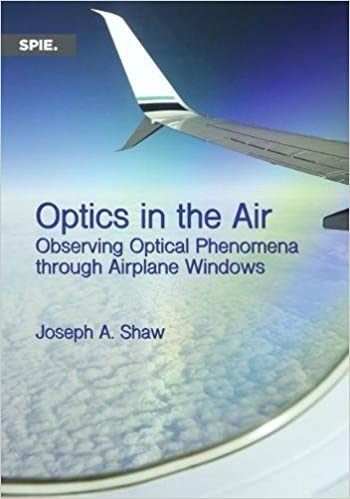
[11] Although no photograph was involved, I will note here an observation attributed to Wells Alan Webb, reported to have occurred on May 5, 1953, near Yuma, Arizona, from 9:45 to 10 AM. (Meessen related and discussed this account in his 2012 paper, on page 527.) I have embedded below Webb's report as it appeared in a 1964 volume titled The UFO Evidence, edited by Richard H. Hall and published by the National Investigations Committee on Aerial Phenomena (NICAP).
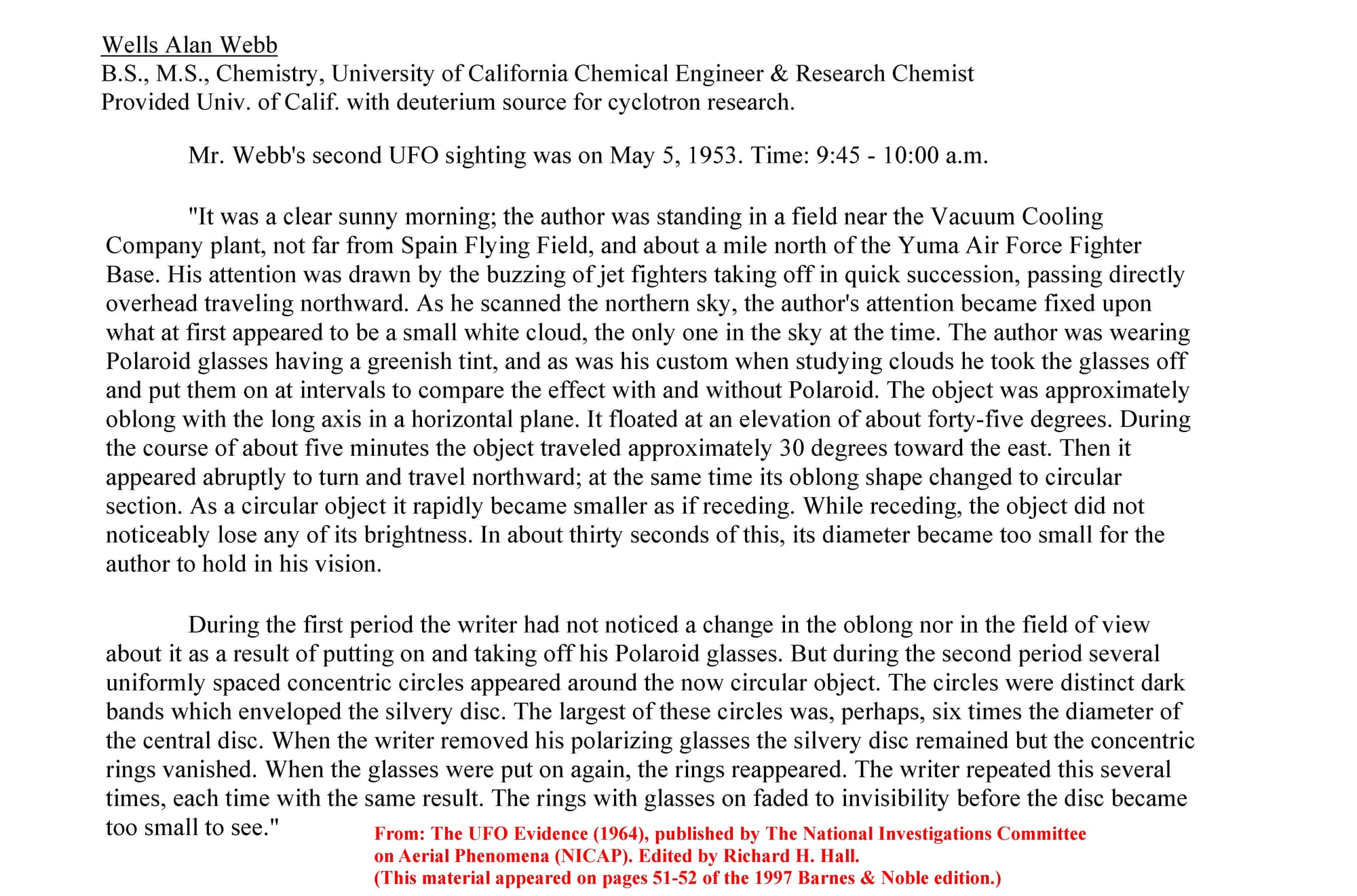

LOG OF REVISIONS AND UPDATES TO THIS ARTICLE SINCE ORIGINAL PUBLICATION
(1) April 5, 2024: I updated End Note No. 5 to incorporate verbatim a response from Prof. Kevin Knuth to my emailed inquiry regarding whether anything had been done to effectuate Knuth's August 2021 public commitments to thoroughly vet and authenticate the Ray Stanford movie of October 5, 1985 ("plasma beam").
(2) April 5, 2024: I updated the subsection headed "The Kevin Knuth Presentation of November 17, 2023," to incorporate verbatim Knuth's emailed response to my questions regarding images taken from the Ray Stanford movie of December 4, 1980. ("I have no information to provide to you, especially since I do not want to make any statements that are going to end up in a disparaging blog post.")
(3) April 6, 2024: I added End Note No. 11, containing a 1953 observation by Wells Alan Webb, who reported that he saw "uniformly spaced concentric circles...distinct dark bands" around a distant UFO, but only when he viewed it through his polarized sunglasses and only when the object had a certain orientation.

